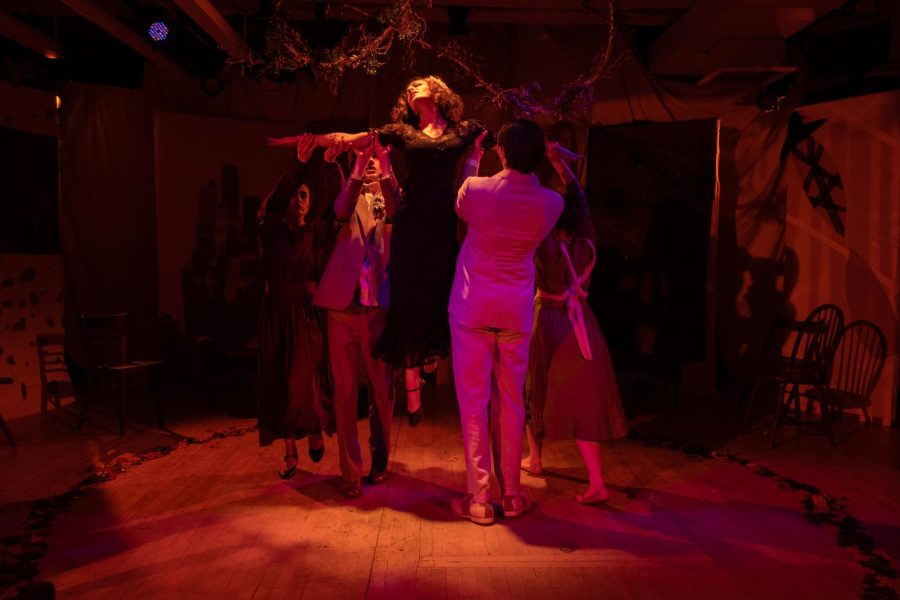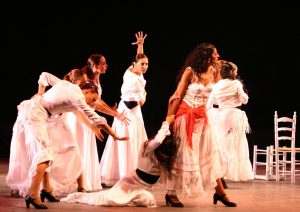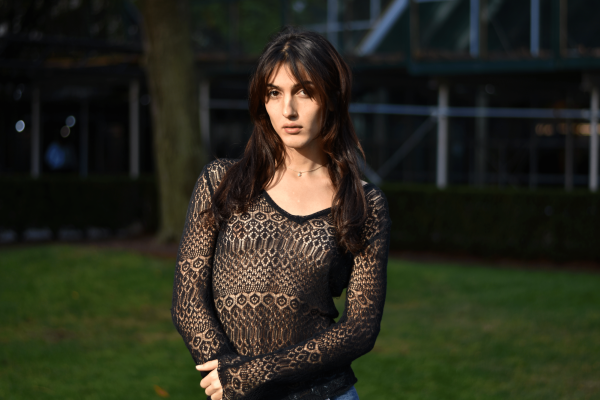‘Blood Wedding’: A Spectacular Display of a Heartbreaking Spanish Tragedy
Fordham Studio’s production of “Blood Wedding” was a triumphant marriage between drama and surrealism in homage to playwright Federico Garciá Lorca
March 23, 2023
From Feb. 27 to March 3, Fordham Studio Theatre presented “Blood Wedding,” written by Federico García Lorca. The play spotlights themes of societal gender expectations, romance, heartbreak and loss, which create a sense of inherent queerness that director Asa Nestlehutt, Fordham College at Lincoln Center (FCLC) ’24, leans into.
“Blood Wedding” is a tragedy about a bride, played by Giordana Simurdiak, FCLC ’24, betrothed to a man but madly in love with another. The play explores forbidden love through the lens of two families beguiled by trauma and social pressures.
Simurdiak was a woman on fire. She portrayed The Bride in a captivating display and brought audience members to tears as she bared her soul on the stage and delivered an unforgettable performance.
The Bridegroom, played by Jack Clark, alongside his mother, played by Mckenna Dixon, both FCLC ’25, meets with The Bride’s Father, played by Alexander Shayeb, FCLC ’25, to profess his love for The Bride and ask for her hand in marriage. Despite The Bride’s obvious unhappiness with the match, the families agree, and the pair are set to be married.
Nestlehutt’s rendition took a village to bring to fruition. It contains a genius original score written by Nate Dallimore, FCLC ’24.
Balancing comedy and seriousness, Clark brought an innate sense of humor to an otherwise melancholic play, and his vocals anchored the songs of the play.
Dixon, the Bridegroom’s Mother, expertly delivered a chilling performance of a grieving mother in the aftermath of her son’s death, evoking an impassioned reaction from viewers.
Shayeb displayed immense acting and singing talent in his portrayal of the Father of The Bride and the Moon. He breathed life into the celestial being.
Upon learning of engagement, Leonardo, played by Anne Lois Bullington, FCLC ’26, leaves behind his pregnant wife, played by Emma Durocher, FCLC ’23, and similarly confesses his love for The Bride, which she reciprocates.
Bullington gives an astonishing portrayal of someone overcome with desire. Her performance establishes her as an incredible addition to the play.
With the biggest singing part of both the Servant and Leonardo’s wife, Durocher gave the play her all. In the final scene, she perfectly portrays a distraught woman.
From the second the house doors open, “Blood Wedding” is a fully immersive experience.
Halfway through the play, directly following the wedding sequence, a transformation occurs. The play takes a surrealist turn as the characters go through a metamorphosis. Leonardo and The Bride subvert societal expectations and run away together. The Bridegroom, who has transformed from the sweet “momma’s boy” into a misogynist, begins a jealous pursuit of his wife and Leonardo. Shayeb and Dixon have a transformation of their own into the Moon and Death respectively.
The Moon and Death are taken from celestial abstracts to plot-furthering characters, dependent on the Bridegroom and Leonardo meeting. This results in the two men tragically dying, leaving the rest of the characters in a state of despair.
Nestlehutt took creative liberty when casting Leonardo and decided to cast him as a woman. This choice was a nod to the playwright’s identity as a closeted gay man. Nestlehutt said they believe that Lorca was writing about a queer relationship; he just didn’t have the ability at the time to explicitly state it.
“Lorca was a queer man and sought to explore themes of homosexuality in his work, but because of where he lived in Spain in the 1930s, he was not able to explore these themes outwardly whatsoever. So, it’s all very heavily coded,” Nestlehutt said.
Nestlehutt’s rendition took a village to bring to fruition. It contains a genius original score written by Nate Dallimore, FCLC ’24. Dallimore had the enormous task of simultaneously being the composer, music director and sound designer.
“The entire summer I spent researching flamenco music, learning the theory behind it from a music education standpoint but also the traditions,” Dallimore said. “I’m trying to learn that and use some of those techniques to make my own type of music.”
Samantha Bohrer, FCLC ’23, choreographed dance sequences that accompanied the music to create flawless musical numbers throughout the performance.
The fantastical set, designed by Haley Crawford, FCLC ’24, was a surrealist painting that came to life, capturing the essence of the the Spanish Countryside. Lee Lillis, FCLC ’24, took the performance to a new level of excellence with his lighting, painting the set and actors beautifully. The lighting also enhanced key plot moments in a visually dynamic way.
Clad with highly stylistic makeup and costumes, designed by Katie Bartlett, FCLC ’25, the actors took to the stage to tell the heartbreaking and erotic story of “Blood Wedding.”
From the second the house doors open, “Blood Wedding” is a fully immersive experience. The lighting is dimmed, the set is beautiful, and the ambient music in the background transforms the Whitebox Theater into a 1930s Spanish Countryside.
Nestlehutt’s directorial debut was simply a triumph. His rendition brought theatricality back to theater and was a feast for the senses. “Blood Wedding” is a perfect example of what happens when artists are inspired. They perform at their best. The talent packed cast and crew came together to create a magnificent performance, not soon to be forgotten by Fordham Theatre.














